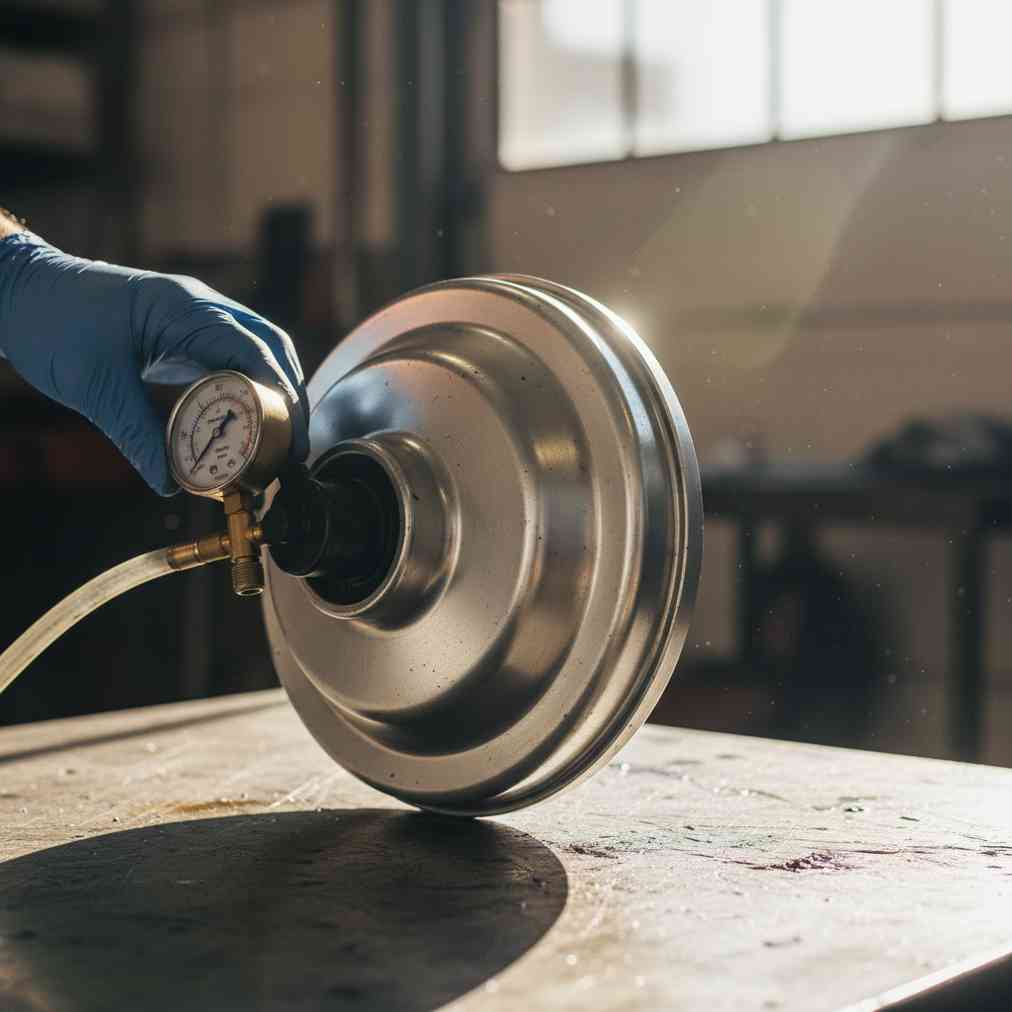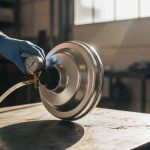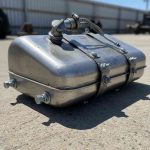Understanding Your Brake Booster and Why Your Pedal Feels Hard
A hard brake pedal is often the first sign that your brake booster is failing. This critical safety component multiplies the force you apply to the brake pedal, making it possible to stop your vehicle with reasonable effort. When it fails, you’ll notice immediately that braking requires significantly more leg strength, potentially putting you and others at risk.
How a Vacuum Brake Booster Works
The most common type of brake booster uses engine vacuum to provide power assistance. In some vehicles like diesels, hybrids, or those operating at high altitudes, a separate vacuum pump may be used instead of relying solely on engine vacuum.
When you press the brake pedal, a control valve allows atmospheric pressure into the working chamber of the booster. This creates a pressure difference across an internal diaphragm, which is held under vacuum on the other side. The pressure difference causes the diaphragm to move, pushing the booster’s push-rod with multiplied force against the master cylinder, providing the power assist that makes braking effortless.
Common Brake Booster Failure Symptoms
Recognizing the signs of a failing brake booster can help you address the issue before it becomes a safety hazard. Here are the most common symptoms to watch for:
- Hard Brake Pedal: The most obvious sign – you’ll need to push much harder to achieve the same braking power. The pedal might feel normal on the first application but get progressively harder on subsequent presses due to loss of vacuum reserve.
- Increased Braking Distance: Your vehicle takes longer to stop due to reduced braking power assistance.
- Engine Stumbling or Stalling: A significant vacuum leak can cause the engine RPMs to drop or stall when brakes are applied.
- Whistling or Hissing Sounds: Vacuum leaks often produce audible sounds, especially when the brake pedal is pressed.
- ABS Warning Light: Fluctuating pressure from a failing booster can sometimes trigger the ABS warning light.
Why Buy a Used Brake Booster
New brake boosters can be expensive, often costing several hundred dollars for many vehicles. A quality used brake booster from a salvage yard near me can provide the same functionality at a fraction of the cost. However, testing the unit before purchase is crucial since brake boosters are safety-critical parts that must function properly.
Step-by-Step Guide to Testing a Used Brake Booster
Visual Inspection
Start your evaluation with a thorough visual inspection:
| Inspection Point | What to Look For | Red Flags |
|---|---|---|
| Housing | Overall condition | Excessive rust, cracks, impact damage |
| Master Cylinder Mounting Surface | Seal integrity | Fluid leaks, pitting, damage |
| Vacuum Connections | Hose and fitting condition | Cracks, brittleness, loose connections |
Check Valve Inspection
The check valve is a one-way valve located where the vacuum hose connects to the booster. This small but critical part prevents vacuum loss when the engine is off.
- Listen Test: With the engine off, remove the vacuum supply hose. A properly functioning check valve should release a “whoosh” sound as vacuum bleeds out. No sound indicates a stuck valve.
- Blow Test: Try blowing air into the check valve opening. Air should flow into the booster but not back out – it’s a one-way valve. If air passes both directions, the valve is faulty.
Basic Operational Tests
These tests simulate on-vehicle operation to check the booster’s ability to hold vacuum and provide assist:
Step 1: Deplete Vacuum Reserve
With the engine OFF, pump the brake pedal 4-5 times until it feels firm and hard. This exhausts any remaining vacuum in the booster.
Step 2: The “Sinking Pedal” Test
Hold the brake pedal firmly in the depressed position where it feels hard from Step 1. Start the engine while maintaining pressure on the pedal.
- Good Booster: The pedal should sink down slightly under your foot as the engine generates vacuum and applies assist.
- Bad Booster: The pedal stays hard and doesn’t move down, indicating the booster isn’t working.
Step 3: Check for Internal Vacuum Leaks
With the engine running, press the brake pedal several times. If the engine RPMs fluctuate or the engine stumbles when you press the pedal, it indicates an internal vacuum leak affecting the air/fuel mixture.
Push-Rod Test for Internal Diaphragm Integrity
This test checks if the internal diaphragm can hold vacuum when the booster is off the vehicle:
- Push the main push-rod (the end that connects to the master cylinder) inward as far as it will go
- While holding the push-rod in, cover the check valve port with your finger
- Slowly release the push rod
- Listen for air leaks – you should NOT hear air escaping from the booster housing
If you hear air escaping from the booster body itself (not around your finger), the internal diaphragm is compromised and the booster should be rejected.
What to Avoid When Buying Used
Certain conditions make a used brake booster unsuitable for purchase, regardless of price. Modern automotive safety systems require properly functioning brake boosters to operate correctly.
- Visible cracks in the housing or mounting surfaces
- Signs of brake fluid contamination inside the booster
- Corroded or damaged vacuum fittings that cannot be repaired
- Failed internal diaphragm (detected through push-rod test)
- Non-functional check valve that cannot be easily replaced
Installation Considerations
Even a good used brake booster requires proper installation to function safely. The mounting surface must be clean and properly sealed, and the push-rod adjustment must be correct. Improper installation can result in brake failure or reduced braking effectiveness.
Many professional mechanics recommend having brake booster installation performed by qualified technicians due to the safety-critical nature of the brake system. The investment in professional installation often pays for itself in peace of mind and proper operation.
Cost Savings vs. Safety
While buying a used brake booster can save significant money compared to new parts, safety should never be compromised. A properly tested used unit from a reputable source can provide years of reliable service. However, if you have any doubts about the unit’s condition during testing, it’s better to look for another one or consider a remanufactured option.
If you’re looking to sell a junk car to help fund your brake repair, getting an instant quote can help you determine if the repair is worth the vehicle’s value.
Final Testing Tips
When testing a used brake booster, bring a small toolkit including basic hand tools and a flashlight for better inspection. Take your time during the evaluation process – a few extra minutes of testing can prevent safety issues and save money in the long run.
Remember that brake boosters are model-specific parts. Verify that the unit you’re testing matches your vehicle’s specifications exactly, including mounting bolt patterns, push-rod configuration, and vacuum connection location. The advances in modern automotive technology mean that even slight variations can prevent proper fitment and operation.
With proper testing and evaluation, a quality used brake booster can restore your vehicle’s braking performance while keeping repair costs manageable. The key is thorough inspection and testing to ensure you’re getting a reliable, safe part for your vehicle’s critical brake system.





Leave a Reply
You must be logged in to post a comment.